The Museum Collections
Introduction
I. History and Art Collection
1. Icons of the 14th – 19th centuries
icons of the 14th – 17th century
2. Jewelry art of the 14th – 20th century
jewelry art of the 14th – 17th century
jewelry art of the 18th – 19th century
the european silver 14th - 19th centuries
3. Small-size sculptures (works of metal, wood, bone)
XI – the beginning of the XX century
Small-size sculptures 11th – 17th century
Small-size sculptures 18th – early 20th century
enamel of Troitza masters 15-8th – early 20th century
5.Embroidery, lace, textiles of the 14th - early 20th century
icon and ornamental embroidery
gold and silver lace
6.Painting of the 18th – 21st centuries
painting of the 18th – 19th centuris
painting of the 20th – 21st centuris
II.Manuscripts and old printed books of the 14th – 17th century
IV.Lithography of the 18th – 19th century
V.Numismatics
VI.Medals of the 18th - early 20th century
VIII.Archeology collection
IX. Russian folk and applied and decorative art of the 17th – 21st c.
1. Artistic wood
folk carved and painted wood
wooden toys
house carving of Sergiev Posad
Khokhloma and Gorodets painting
2. Artistic textiles
embroidery and weaving
printed textiles and lace
Russian shawls
folk costumes
folk garments
printed cotton kerchiefs
|
Archaeological collections (p. 1)
|
Àrchaeological collections of Sergiev-Posad museum-preserve are the result (twenty years') researches of archaeological expedition (more represents than 3500 units). Researches of antiquities in vicinities of the Trinity-St.Sergius Lavra have almost century tradition and conduct the beginning from Zorian Dolengo-Hodakovsky. The archaeological monuments presented to expositions «The Most ancient past of Sergiev-Posad land » reflect some epoch - from the Stone Age (7-6th centuries BC) till an epoch of Ancient Russia - the early Middle Ages (11-13th centuries).
Discoveries from the site Zamostye-2: stone products nucleuses, tips of arrows, scrapers (for clearing skins), edges, scrapers, strickles, drills, loose leaves for compound tools, it is rough struggled adzes, chisels and axes (for manufacturing of boats- chiseled) concerns to the Stone Age (mesolit and neolith epochs). On the site Zamostye-2, the occupation layer is under water and in it remained not only a stone, ceramics, but also bone and even wooden things: pales, parts of boats, sledge, oars, shovels, spears, arrows, couplers for fastening of stone axes, a part of vessels, sculpture. Tips of arrows, spears, harpoons, fish-forks, axes, mattocks were made of a horn and a bone. Forms of tips of arrows from a bone are extremely various.
|
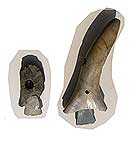
Axe and adze with coupler. Mesolithic. Site on the Dubna river. |
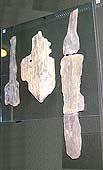
Wooden oars. Mesolithic. Site Zamostye-2. |
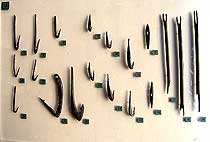
Fishing bone hooks. Mesolithic. Site Zamostye-2.
|
|
So-called put-in tools also found in Mesolithic layers of the site Zamostye-2 and on the site Samotovino-1 were essentially new for Mesolithic on the technician of manufacturing. These are two daggers and a tip of the spear, cut out from a bone and a horn of an elk. Such finds are exclusively rare in territory of the European Russia.
The special category of finds made up art subjects. First, it is the whole series “churings” - ornament pebbles, with soot and fat stains and traces of blows. A considerable series of “churings” (45 pieces) was found only on the site Zamostye-2. However, “churings” were found practically in materials of all cultures of the Stone Age of Eurasia.
Finds of sculptural images of goals of an elk with an aperture for a nozzle on a handle are unique. A small hump on a nose, eyes and ears of an elk are executed is very realistic, one of images is decorated on lateral faces by a geometrical ornament. These finds obviously were sacred staffs of shamans or breeding leaders. The collection Mesolithic antiquities of the Sergiev-Posad museum is the largest in the central Russia (such is not present in the Hermitage).
|
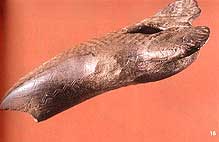
Fighting die in the form of a head of an elk. Mesolithic. Site Zamostye-2. |

Put-in knifes. Mesolithic. Site Zamostye-2. |
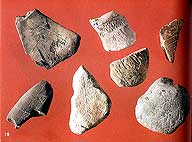
Stone amulets - «churings». Mesolithic. Site Zamostye-2.
|
To Neolithic epoch concern: ceramic pots, entirely covered with the original ornament consisting of numbers of round poles, drifted by a fossilized mollusc belemnit, (so-called “a devil's finger”), the "combs" drifted by a gear pebble, other stamps, among which could be both a nail, and the end of the bird's stone. The bottoms were made roundish or sharpened, and the vessel perfectly was put between stones of the centre or in deepening in the earth.
On settlements of Neolithic, archeologists allocate first three Neolithic cultures:
1. Head-Volga culture (an early neolith, 2-half 6 thousand - 4 thousand BC) on various ornamental of ceramics. Vessels of head-Volga cultures - poorly burnt, thin-walled, moulded by hand, without potter's wheel application, had sharp or roundish (occasionally - flat) the bottoms. Surface of them entirely has covered by an ornament from prints of narrow comb, annulated and other stamps.
The image of a human figure was put on a fragment of collum of head-Volga vessel with the lifted hands, on external side the sun represented with raying.
Lyalovsky culture (the developed neolith, 4-3 thousand BC). Vessels of Lyalovsky culture have egg-shaped form, sharp and round bottoms. All surfaces have decorated by the so-called pit-comb-type ornament, consisting of numbers of conic poles, put in chessboard order by belemnit - a fossilized mollusc, so-called “a devil's finger”. Fields of the conic poles, placed in chessboard order, alternate by numbers of the "combs drifted by a gear pebble, prints of toothed, semilunar, rope and other stamps.
For things of Lyalovsky sites, it is characteristic some more variety of bone tools: tips of arrows, harpoons, hooks, mattocks, chisels, daggers, knifes. Silicon tools were produced from chip off bits - large oval forms silicon chips, the surface processed by a so-called retouch - small chips, which gave to a subject ideally correct outlines. Stone axes, adzes, chisels were polished by sand and other abrasives to mirror shine.
Volosovsky culture. (Neolithic, 2 quarter of 3 thousand - the 2 thousand middle BC)
For Volosovsky cultures, it is typical thick-walled vessels with an impurity in the clay paste of a pounded bowl, and at a late stage - grasses. Forms of vessels - round-bottom, and at a late stage - flat-bottomed. Volosovsky flat polish ornaments-pendants with apertures, cut out from a stone or a bone, were had found also. Some scientists consider bearers of Volosovsky culture protofinno-ugric, i.e. immediate ancestors of tribes of "mesh" ceramics of the Bronze Age, descendants of which were tribes “merya”, “muromian”, “ves” and others.
|
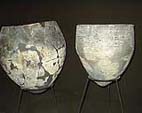
Ceramic vessels. Neolithic. Head-Volga culture. Site Zamostye-2. |
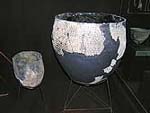
Ceramic vessels. Lyalovsky culture. Neolithic. Head-Volga culture. Site Zamostye-2. |
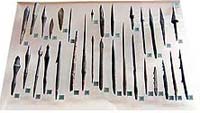
Bone tips of arrows. Neolithic. Head-Volga and Lyalovsky cultures culture. Site Zamostye-2. |
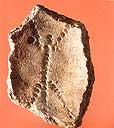
The fragment of the Head-Volga vessel. Site Zamostye-2.
|
|


